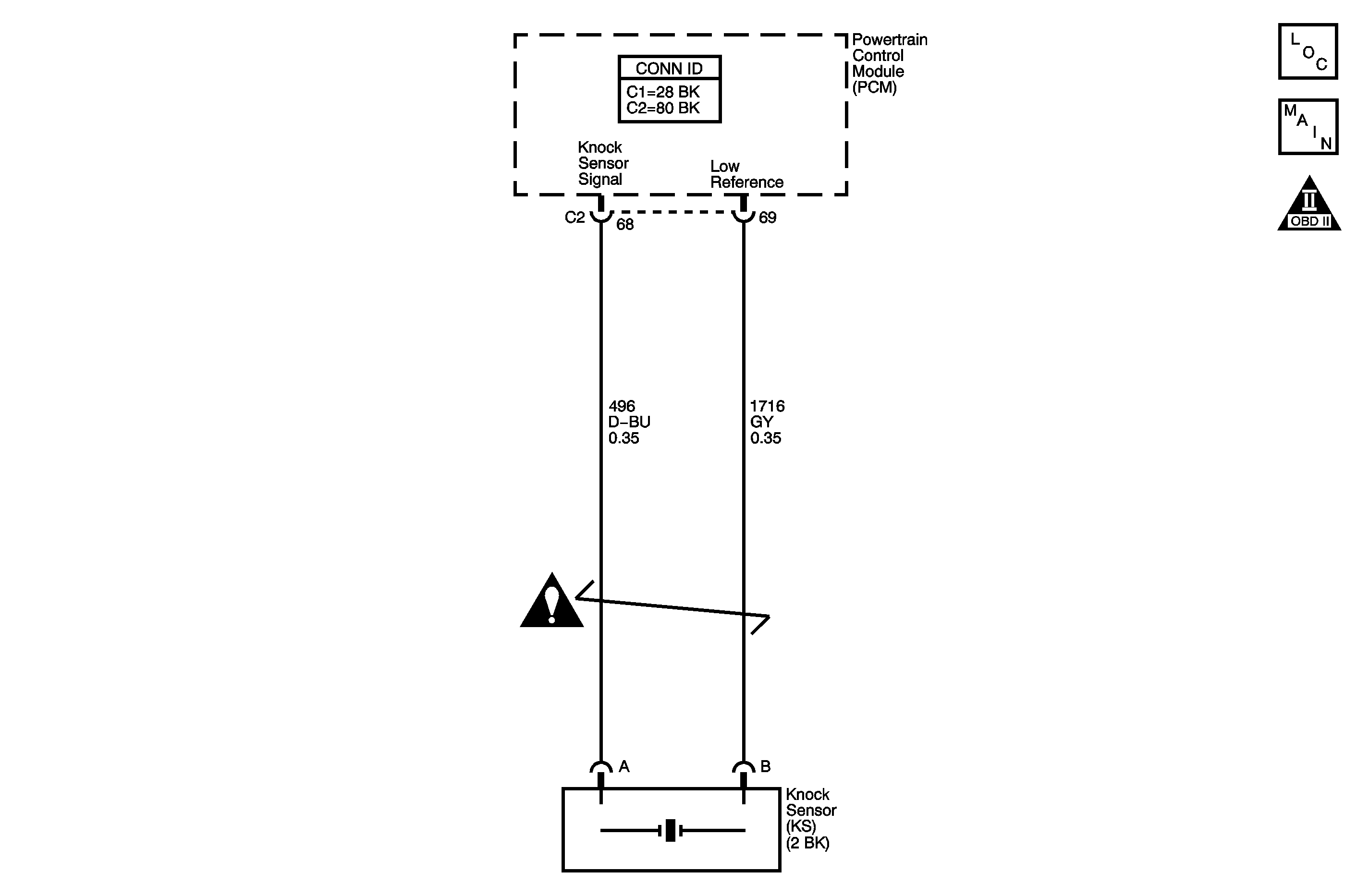
Circuit Description
The knock sensor (KS) system enables the powertrain control module (PCM) to control the ignition timing for the best possible performance while protecting the engine from potentially damaging levels of detonation. The KS is located on the intake side of the engine block. The KS produces an AC voltage signal that varies depending on the vibration level during engine operation. The PCM adjusts the spark timing based on the amplitude and the frequency of the KS signal. The PCM receives the KS signal through a signal circuit. The KS ground is supplied by the PCM through a low reference circuit. The PCM learns a minimum KS noise level at idle and uses calibrated values for the rest of the RPM range. The PCM should monitor a normal KS signal within the noise channel. If the PCM malfunctions in a manner that will not allow proper diagnosis of the KS system or the KS signal is not present, DTC P0325 will set.
DTC Descriptor
This diagnostic supports the following DTC:
DTC P0325 Knock Sensor (KS) Circuit
Conditions for Running the DTC
| • | The engine speed is more than 1,800 RPM. |
| • | DTC P0325 runs continuously when the above conditions are met. |
Conditions for Setting the DTC
The average KS voltage is less than 0.01 volts or more than 4.9 volts for 8 seconds.
Action Taken When the DTC Sets
| • | The control module illuminates the malfunction indicator lamp (MIL) on the second consecutive ignition cycle that the diagnostic runs and fails. |
| • | The control module records the operating conditions at the time the diagnostic fails. The first time the diagnostic fails, the control module stores this information in the Failure Records. If the diagnostic reports a failure on the second consecutive ignition cycle, the control module records the operating conditions at the time of the failure. The control module writes the operating conditions to the Freeze Frame and updates the Failure Records. |
Conditions for Clearing the MIL/DTC
| • | The control module turns OFF the malfunction indicator lamp (MIL) after 3 consecutive ignition cycles that the diagnostic runs and does not fail. |
| • | A current DTC, Last Test Failed, clears when the diagnostic runs and passes. |
| • | A history DTC clears after 40 consecutive warm-up cycles, if no failures are reported by this or any other emission related diagnostic. |
| • | Clear the MIL and the DTC with a scan tool. |
Step | Action | Values | Yes | No | ||||||||
|---|---|---|---|---|---|---|---|---|---|---|---|---|
Schematic Reference: Engine Controls Schematics Connector End View Reference: Powertrain Control Module Connector End Views or Engine Controls Connector End Views | ||||||||||||
1 | Did you perform the Diagnostic System Check - Engine Controls? | -- | Go to Step 2 | |||||||||
2 |
Does the DTC fail this ignition? | -- | Go to Step 10 | Go to Intermittent Conditions | ||||||||
3 |
Does the DMM display an open for both circuits? | -- | Go to Step 4 | Go to Step 7 | ||||||||
4 |
Is the voltage more than the specified value on any circuit? | 4.2 V | Go to Step 5 | Go to Step 6 | ||||||||
5 |
Did you find and correct the condition? | -- | Go to Step 11 | Go to Step 8 | ||||||||
6 |
Did you find and correct the condition? | -- | Go to Step 11 | Go to Step 8 | ||||||||
7 | Test for an intermittent and for a poor connection at the KS. Refer to Testing for Intermittent Conditions and Poor Connections and Connector Repairs . Did you find and correct the condition? | -- | Go to Step 11 | Go to Step 9 | ||||||||
8 | Test for an intermittent and for a poor connection at the PCM. Refer to Testing for Intermittent Conditions and Poor Connections and Connector Repairs . Did you find and correct the condition? | -- | Go to Step 11 | Go to Step 10 | ||||||||
9 | Replace the KS. Refer to Knock Sensor Replacement . Did you complete the replacement? | -- | Go to Step 11 | -- | ||||||||
10 | Replace the PCM. Refer to Powertrain Control Module Replacement in Computer/Integrating Systems for replacement, setup, and programming. Did you complete the replacement? | -- | Go to Step 11 | -- | ||||||||
11 |
Did the DTC fail this ignition? | -- | Go to Step 2 | Go to Step 12 | ||||||||
12 | Observe the Capture Info with a scan tool. Are there any DTCs that have not been diagnosed? | -- | System OK | |||||||||
